2023 Toyota Prius Prime Review and Test Drive
Sensibility, now infused with style and a hint of speed.
 Christian Wardlaw
Christian Wardlaw
QuickTakes:
It has been my long-standing assertion that the Toyota Prius is the best car for most people, most of the time. With a base price of less than $29,000, comfortable seating for four people, a roomy cargo area with seats that fold down for added utility, available all-wheel drive, a reputation for reliability, and historically favorable crash-test ratings, it's a sensible choice. Oh, and it gets terrific gas mileage, too.
As I see it, the problem with the Prius has always been its lack of style and driving pleasure. But with the redesigned 2023 Toyota Prius, the automaker adds a bit of both. And that is especially true of the 2023 Prius Prime, the plug-in hybrid version of the car with 220 horsepower.
Toyota estimates the Prius Prime will travel 39 to 44 miles on a full battery charge, which means people with short commutes may be able to get around mainly on electricity. On longer trips, the gasoline engine turns on, allowing the Prius Prime to continue beyond the electric-only range. Driven this way, the Prius Prime gets a Toyota-estimated 48 to 52 mpg in combined driving as a hybrid car. The lower range and mileage figures are for the XSE and XSE Premium trim levels due to their larger 19-inch wheels.
 Christian Wardlaw
Christian Wardlaw
In addition, Toyota estimates that a Prius Prime will accelerate from zero to 60 mph in 6.6 seconds. That's good by modern standards — and downright fast for a Prius. This "athletic side," as Toyota puts it, is likely why the automaker sells the Prime in its traditionally sporty trim levels: SE, XSE, and XSE Premium.
This year, 2023 Toyota Prius Prime prices range from the low $30,000s to the low $40,000s, including the destination charge to ship the car from the Aichi, Japan, factory that builds it to your local dealership.
For this Prius Prime review, I test-drove the XSE in Southern California. It had a 12.3-inch touchscreen infotainment system, a fixed glass roof upgrade, all-weather floor mats, and a carpeted cargo mat. Those options brought the manufacturer's suggested retail price to $38,729, including the $1,095 destination charge. Toyota provided the vehicle for this Prius Prime review.
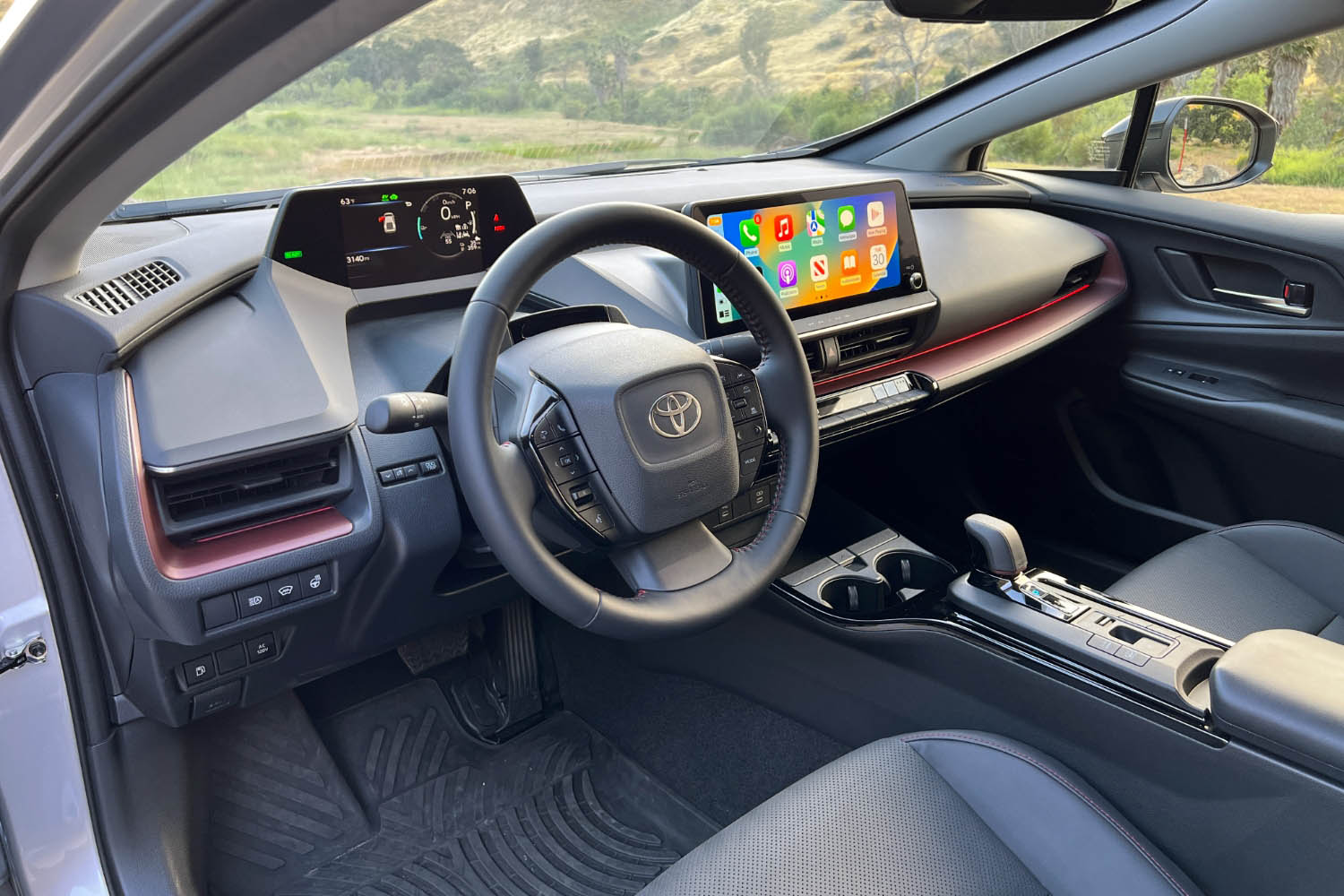 Christian Wardlaw
Christian Wardlaw
2023 Toyota Prius Prime Review: The Design
Although the redesigned 2023 Prius sticks with the aerodynamic five-door hatchback shape it has worn for two decades, I feel the fifth-generation model displays elegance and artistry — traits lacking in previous models. The lighting elements, design details, and proportions reflect a new level of sophistication, and I think the available 19-inch alloy wheels are genuinely stylish.
The standard Prius and the Prime look nearly identical, with only subtle differences, such as the Prime's available solar-charging roof featuring embedded solar panels hidden under a glossy surface. The solar roof helps recharge the battery when the car is parked and power the air conditioning and other accessories when driving. It is an option with XSE Premium trim.
Inside, the Prius and the Prime boast a new interior with modern technology and onscreen graphics. In addition, the car's cabin has a comparatively traditional control layout that puts the digital instrumentation in front of the driver instead of in the middle of the dashboard like in past Prius models. The instrument panel appears to float within a continuous arc that wraps from door to door under the windshield.
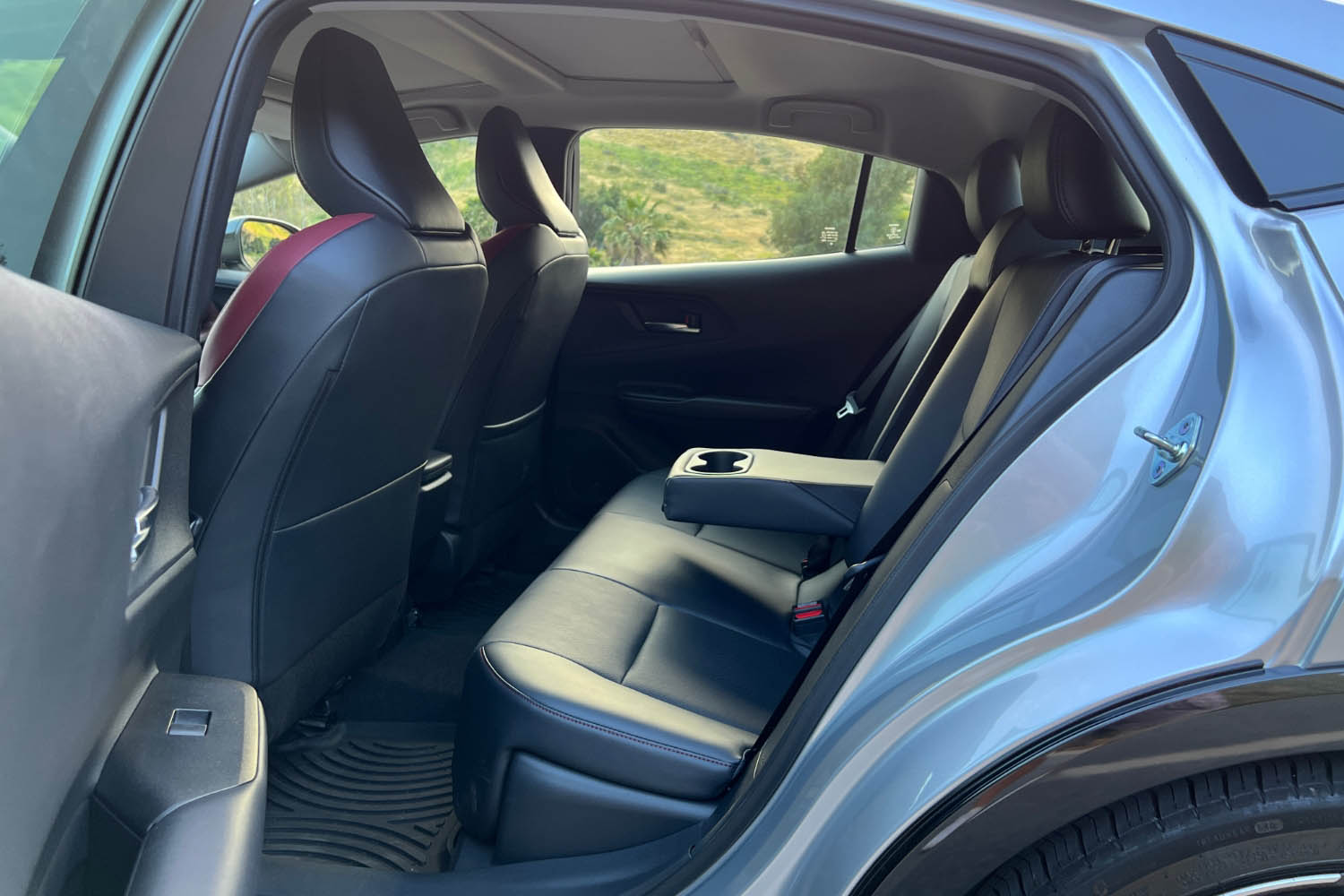 Christian Wardlaw
Christian Wardlaw
While the interior looks good, it feels smaller inside. But, when you compare the specs with the previous-generation model, the Prime's cabin is about the same size, and there's slightly more cargo space.
All Prius Primes have single-zone automatic climate control and a heated steering wheel. With SE trim, the car features fabric upholstery and front seats with manual height adjustment. The Prius Prime XSE adds an eight-way power driver's seat, heated front seats, and artificial leather. Upgrade to the XSE Premium for standard ventilated front seats and available heated rear outboard seat cushions.
I needed to duck more than usual when getting into the Prius Prime due to the rakish windshield pillars. Also, while entering the car, I almost whacked my right knee into the jutting left corner of the dashboard several times. Once inside, I found the XSE's power-adjustable driver's seat quite comfortable. However, the weather during the testing week was unseasonably cool, and in my experience, Toyota's SofTex simulated leather traps sweat. Therefore, I'd recommend upgrading to the XSE Premium if you live somewhere hot and humid.
You might read in other Prius reviews that the steering wheel blocks part of the driver's view of the digital instrumentation. That was not a problem for me, because I like to sit high in a vehicle, so I usually raise the seat well off the floor. So positioned, I had a clear view of the gauges.
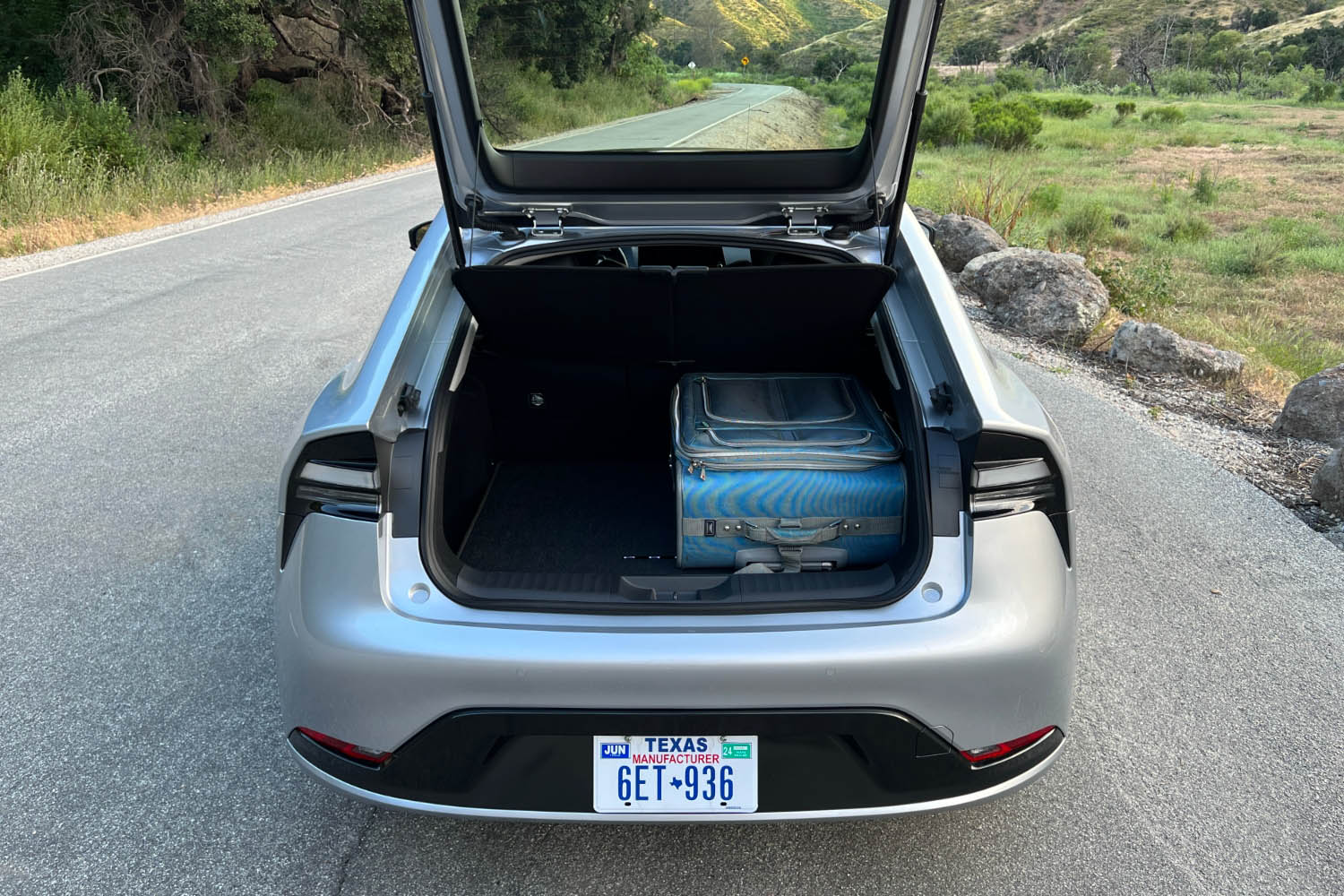 Christian Wardlaw
Christian Wardlaw
The low roofline also requires ducking when getting into the back seat. Once you're in, you'll find comfort on a cushion supplying decent thigh support and an adequately angled backrest. However, the test car did not have rear air-conditioning vents, and the headroom was snug even for my long-legged, short-torsoed frame. The test car's overhead glass roof panel was a nice touch, but sitting under it, on SofTex, on a summer day, without any air-conditioning vents, may equate to a sauna session.
Storage is suitable for this size car. The bin under the center armrest offers lots of space, and the glove compartment has extra room. Toyota also provides small containers in each door armrest and lower door panel, and a tray located in front of the transmission shifter has a hidden compartment beneath it. Four cupholders help quench everyone's thirst.
In addition, a smartphone charger lives to the right of the shifter, a narrow slot into which you drop your device on its side. Unfortunately, the design makes it hard to clean, and its location means it will collect dust, crumbs, and drips.
The Toyota Prius Prime has a 20.3 cubic-foot trunk. To put that into perspective, a Toyota Camry Hybrid carries 15.1 cu-ft in its trunk. To use all of the Prius's cargo volume, however, you need to remove the cargo cover, pack the car to the ceiling, and block the rear window.
The Prius Prime gains superior utility when you fold the back seats down and fill the car to the front seatbacks. Unfortunately, Toyota doesn't publish a maximum cargo volume measurement, but the Prius Prime's hatchback configuration makes it more useful for carrying larger, bulkier items.
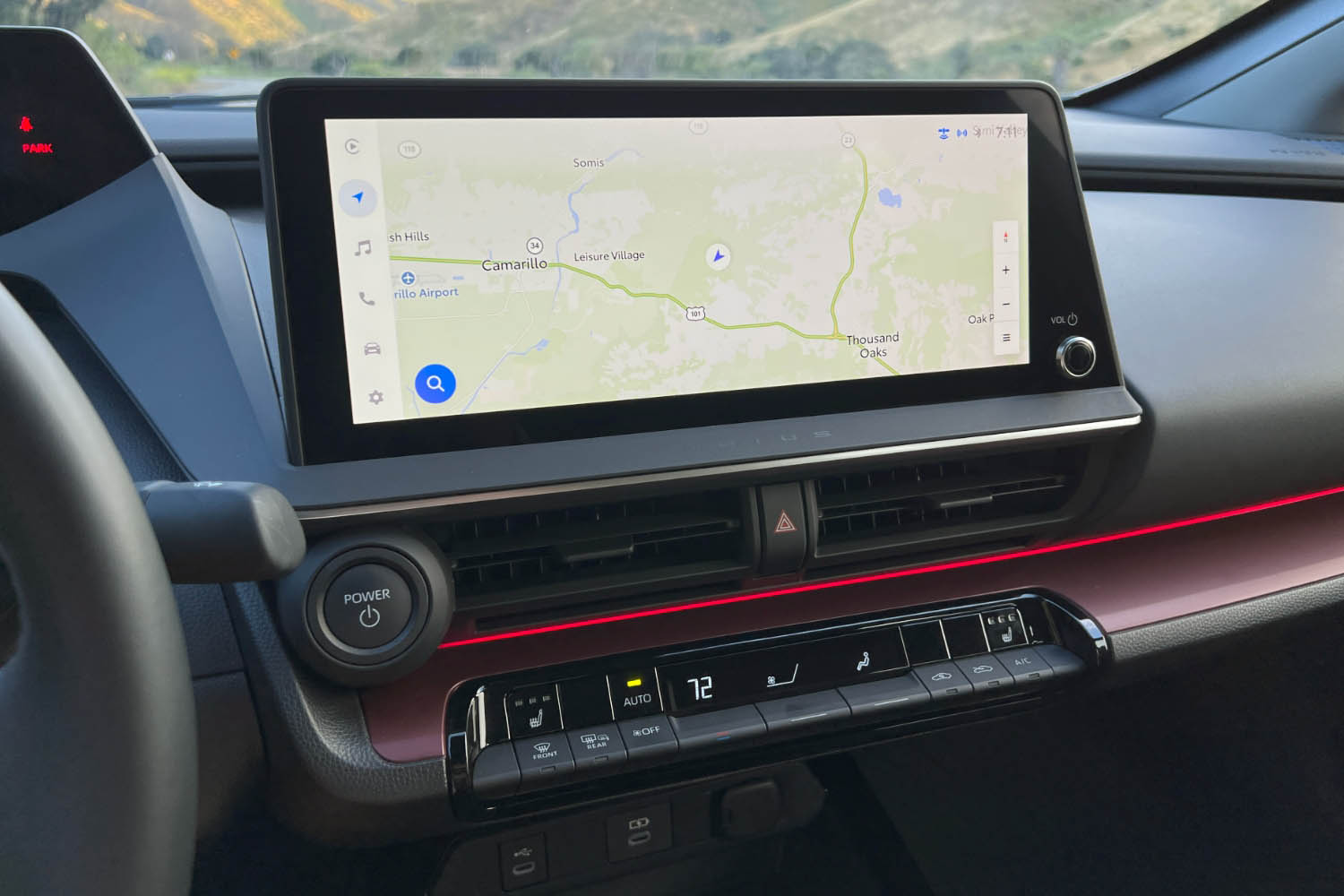 Christian Wardlaw
Christian Wardlaw
2023 Toyota Prius Prime Review: The Technology
In my opinion, Toyota's approach to this car's digital instrumentation display is flawed. First, some reviewers report the steering wheel blocks a full view of the display (not a problem for me, as explained earlier). Second, the 7.0-inch display feels smaller and farther away from the driver's eyes than is typical. Third, I think Toyota crammed too much data onto the display, making it seem busy and disorganized.
The redesigned Prius has the latest Toyota Audio Multimedia infotainment technology. An 8.0-inch touchscreen is standard (SE, XSE), and a 12.3-inch touchscreen is available (XSE, XSE Premium). Both versions of the technology include wireless Apple CarPlay and Android Auto, SiriusXM satellite radio, and five connected service plans with complimentary trial subscriptions for varying periods.
My test car had the larger 12.3-inch touchscreen. More importantly, it had an active Drive Connect subscription, which adds a cloud-based navigation system, Google points of interest, an Intelligent Assistant natural-voice-recognition system, and a Destination Assist concierge service. You rouse the Intelligent Assistant by saying, "Hey, Toyota," or pushing the talk button on the steering wheel. Overall, I think it's an excellent system, though it stumbled when I said in a slightly panicked manner: "I need to go to a hospital!" The resulting list did not filter medical facilities only for hospitals.
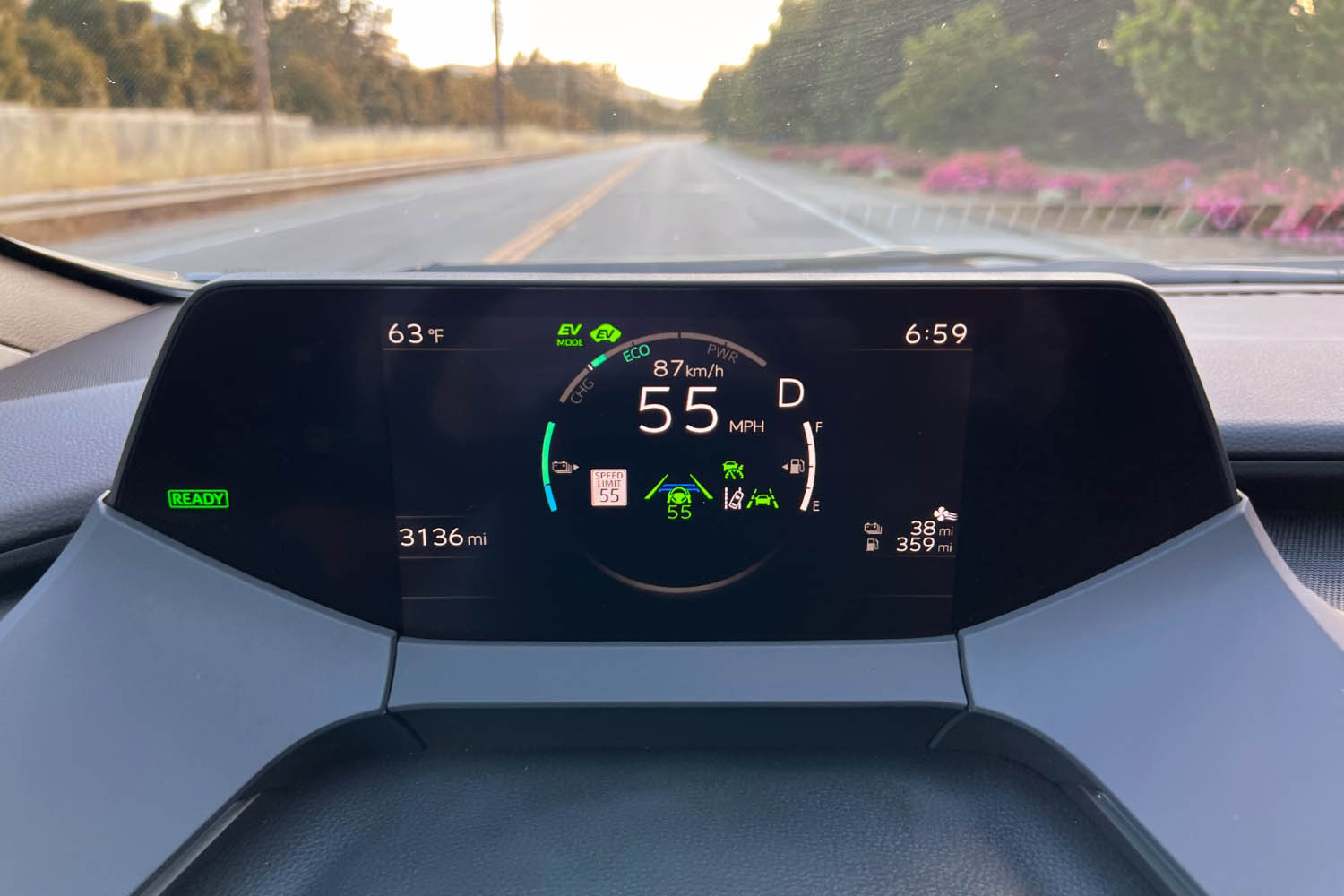 Christian Wardlaw
Christian Wardlaw
Each time I got into the Prius Prime, Apple CarPlay launched. I would like a choice in the matter, though I realize some people prefer this behavior. What I found more aggravating is the location of the stereo volume knob. It's so far to the right that despite my long arms, I had to lean forward and over to use it. My test car had an adequate six-speaker sound system. Get the XSE Premium, and you'll enjoy an eight-speaker JBL premium sound system.
Additional technologies include a smartphone digital key function (through the Remote Connect service plan) and a digital rearview mirror. Unfortunately, the camera-based digital rearview mirror is optional only for the XSE Premium trim. Since I found the new Prius doesn't offer a good view to the rear, I think this feature would be helpful to all of Toyota's customers. A surround-view camera is also available, and Toyota similarly reserves it for the top trim level.
Toyota Safety Sense 3.0 (TSS 3.0) is standard and packages together commonly expected advanced driving-assistance systems. In addition to TSS 3.0, all Prius Primes have a blind-spot monitoring system with rear cross-traffic alert, a rear-seat reminder system, and a safe-exit-assist system. Depending on the trim level, you can also get front and rear parking sensors with automatic braking and an Advanced Park system that takes over the steering, brakes, and acceleration to put the car into a parking space.
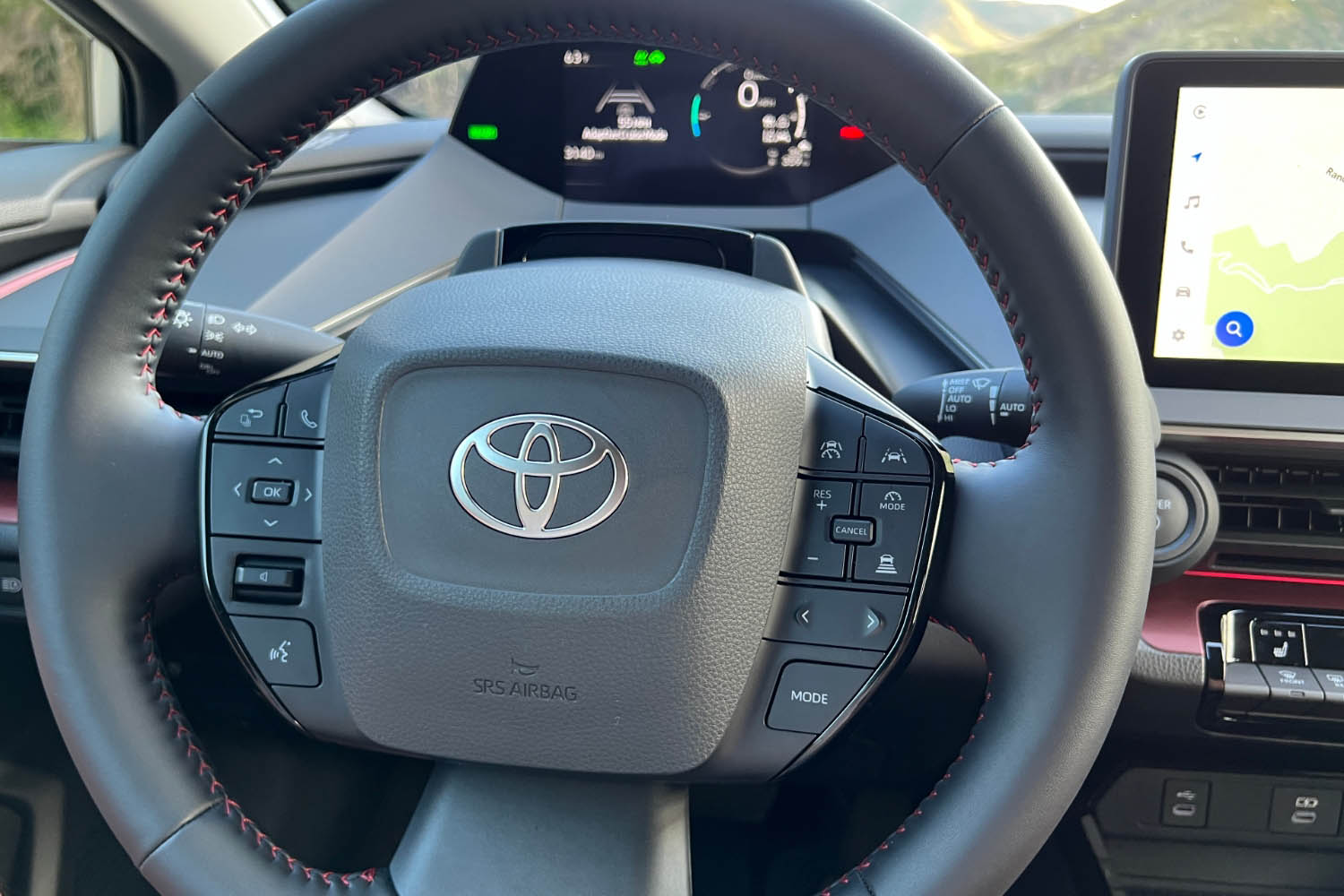 Christian Wardlaw
Christian Wardlaw
As part of TSS 3.0, a new Proactive Driving Assist technology is standard. As you drive, this feature can automatically help you maintain a safe following distance to traffic ahead or brake if necessary, such as when a car in front of you slows to make a turn. The technology is relatively subtle in most situations, but ultimately I turned it off. To me, it felt like a ghost in the machine.
The TSS 3.0 package also equips the Prius Prime with Traffic Jam Assist. Toyota says it requires an active Drive Connect subscription to work, and this feature pairs the adaptive cruise control system with lane-centering assist to actively manage travel at slower speeds, such as when driving in heavy traffic.
I did not get a chance to sample Traffic Jam Assist. However, I extensively used the adaptive cruise control and lane-centering assist systems and observed the uncertainty I've come to expect from Toyota's lane-centering technology. It is particularly evident on highway curves and when driving in the right lane of a freeway and passing exit and entrance ramps. In addition, the adaptive cruise control system automatically slows the car for curves. I think it slows too much.
As of this writing, the National Highway Traffic Safety Administration (NHTSA) and the Insurance Institute for Highway Safety (IIHS) haven't published crash-test ratings for the Prius Prime. Check the
 Christian Wardlaw
Christian Wardlaw
2023 Toyota Prius Prime Review: The Drive
The 2023 Toyota Prius Prime owes its improved performance to a new powertrain. The plug-in hybrid electric vehicle (PHEV) uses a 2.0-liter four-cylinder gasoline engine, a 13.6-kWh lithium-ion battery, and a 120-kW electric motor to generate a net combined output of 220 horsepower. The Prime is front-wheel drive, and Toyota says it fully recharges in 11 hours when using a standard household power outlet and in four hours when using a 240-volt Level 2 home charging station or public charger.
In other words, many drivers will be able to buy this car and, without adding any new electrical outlets or hardware to their homes, recharge it every night and drive mostly on battery power the following day. When a longer trip is called for, whether across a city or the entire country, the gasoline engine keeps the Prius Prime going without its driver ever needing to find a place to plug the car in.
You can also choose how to use the electricity stored in the car's battery. In EV mode, the Prime mostly uses the battery alone, the gasoline engine firing up only when necessary to add more power. Choose EV Auto mode, and the car automatically decides when to use electric-only driving to maximize efficiency. In the HV driving mode, the Prime operates as a hybrid and always provides maximum power. Or, you can choose EV Hold Charge mode to use the gasoline engine and save electric driving for a specific time and place.
 Christian Wardlaw
Christian Wardlaw
Toyota says the Prius Prime XSE should provide 39 miles of electric driving range and then get 48 mpg in combined driving after the gasoline engine turns on. Though I could charge the car to an indicated 40 miles of range several times during my week with the vehicle, I started my evaluation drive with a predicted 33 miles of range and the Prime in its EV mode. In addition, there are four other driving modes: Eco, Normal, Sport, and Custom. I chose Normal mode.
With these selections, the Prius Prime XSE traveled 34.1 miles in EV mode, and the EV driving ratio was 95%. On several occasions, the gas engine turned on to assist with acceleration, especially when driving into the Santa Monica Mountains near Los Angeles, where the elevation gain was approximately 800 feet over several miles.
After the battery reached its minimum state of charge, the Prime XSE averaged 46.4 mpg, a little lower than the Toyota estimate of 48 mpg for that trim level.
When driving the Prius Prime in EV mode, the car makes a pleasing whirring sound and has no trouble in city traffic or cruising on the highway. Demand too much power, and the gas engine automatically turns on to assist, but only briefly. Switch to HV mode, and acceleration is swift. However, I found the steady-state droning of the gas engine to be unpleasant.
The new Prius sits on an updated version of the Toyota New Global Architecture (TNGA) platform the company developed to improve the driving dynamics of its vehicles. In combination with a strut front, multilink rear suspension design and the XSE's 19-inch wheels and tires, the TNGA platform contributes to the Prime's commendable ride and handling. Not only that, but the Prime also feels structurally stiff and robust when traveling over imperfect pavement.
 Christian Wardlaw
Christian Wardlaw
In addition, the blended regenerative braking system feels natural at the pedal, ensuring drivers can consistently bring the car to a smooth and sure stop. A "B Mode" adds sharper regeneration when you lift your foot off the accelerator, but the Prime does not offer one-pedal driving.
Unfortunately, the Prime XSE suffers plenty of road noise at higher speeds. Wind noise is also evident, somewhat surprising given the car's slippery drag coefficient. In addition, I found the steering to be numb and artificially assisted.
More concerning is the new Prius Prime's compromised outward visibility. During my evaluation, I found the windshield pillars seemed wider and the roofline seemed lower than on the previous generation car's. Also, the vertical rear glass panel is gone, and while the test vehicle had front and rear parking sensors, I found it difficult to judge the front corners, regularly erring on the side of caution when parking the car.
To improve visibility and give drivers more confidence, I think Toyota should make the available digital rearview mirror and surround-view camera systems more widely available.
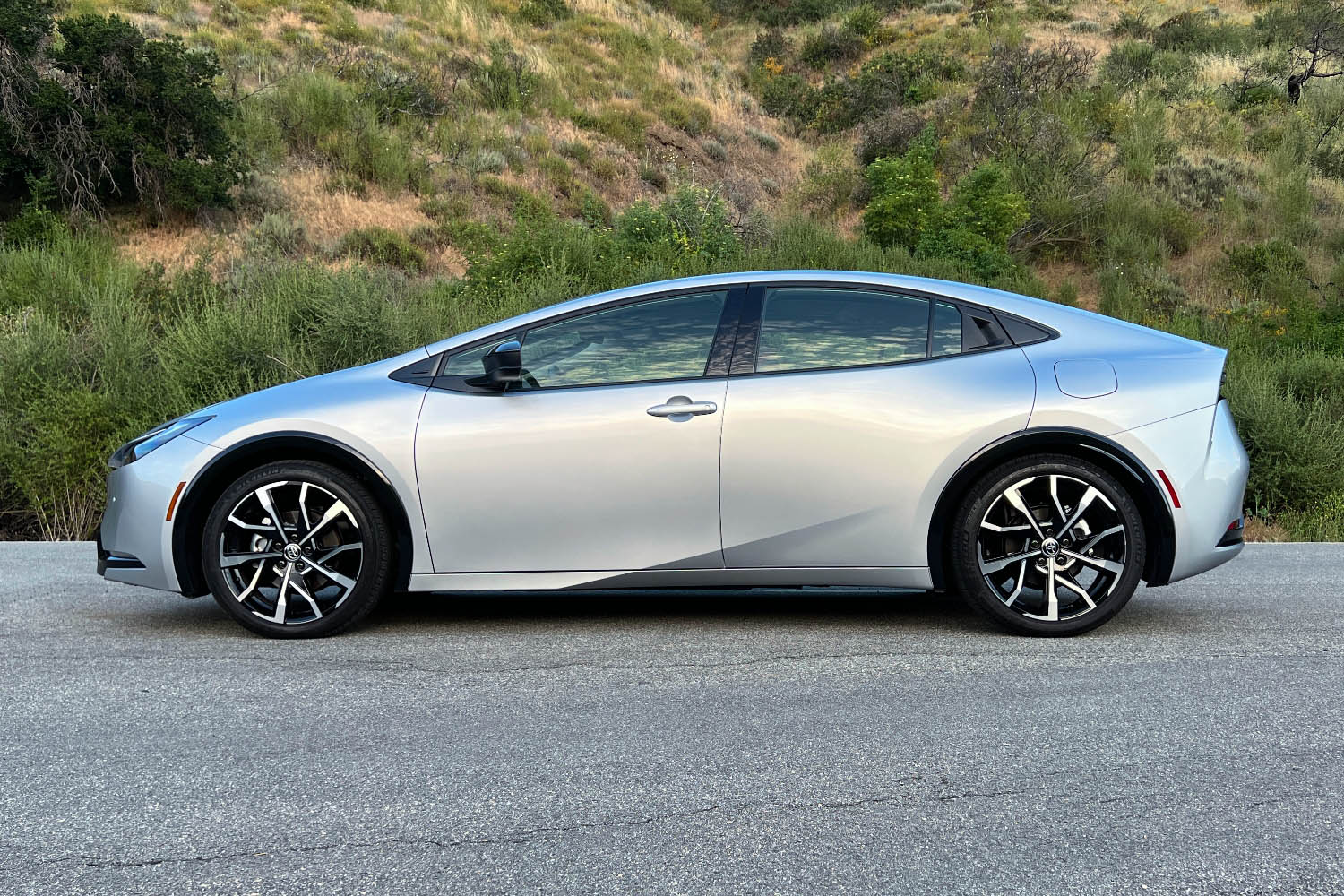 Christian Wardlaw
Christian Wardlaw
Is the 2023 Toyota Prius Prime a Good Car?
During my week with the Prius Prime, I pulled into an expensive hotel on the beach. The valet, an eager Zillennial, strode up and effusively praised the car. Assuming they were joking, I laughed — but the enthusiasm was genuine.
So I engaged in a conversation and, come to find out, they were big fans of all Prius models. We're talking about every generation of the model, going back decades. I did not see that coming — and if there is one person like this valet, there are more.
Overall, I like the 2023 Toyota Prius Prime. During a week living with one, I had to go out of my way to burn gas because the recharged battery effortlessly handled kid-shuttling, errand-running, and other local activities. Then, when work called me 75 miles from home, the Prime's gas engine made a day in the field worry-free. With a PHEV, you never suffer range anxiety or concern about finding an open, fully functional EV charging station in uncharted territory.
Nothing about this evaluation has changed my mind about the Prius. It's a perfect car for people who drive because they need to, not because they want to. Better yet, now it has a sense of style — and can accelerate out of its own way.
All vehicle pricing includes MSRP plus destination charges (set at the time of publication), and will be rounded to the nearest thousand.



